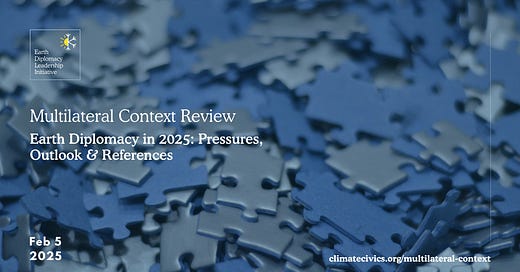Earth Diplomacy in 2025: Pressures, Outlook & References
As multilateral conditions are shifting, CCI will host a special webinar on the pressures affecting Earth diplomacy and sustainable development in 2025.
Wednesday, February 5, 2025
9:00 am EST / 11:00 am BRT (Belem) / 2:00 pm UTC / 6:00 pm AZT (Baku)
On Wednesday, February 5, 2025, CCI will host a special informal Earth Diplomacy Leadership discussion forum, to look at:
The Baku Pact and wider climate progress;
Guiding Insights from the Livable Future report;
Key moments for multilateral cooperation in 2025;
And the evolving geopolitical landscape.
Climate disruption affects every region of the world, projecting risk and impact through a vital system that spans the entire planet. All life on Earth—the whole of the biosphere—is affected. Since the 1980s, the community of nations has sought to craft an effective international cooperative response that would:
Stop heating the planet;
Reduce risk and build resilience;
Foster closer international ties;
And uplift humanity through sustainable development.
Over the last few years, it has become increasingly common to hear talk of shifting trade, finance, and everyday economies, to align with a future of climate-resilient development. This discussion has been driven partly by the recognition that climate-smart trade and finance are needed to create the new opportunities that will allow the whole economy to mobilize climate solutions, and partly by the recognition that both trade and finance will face serious challenges in a world of persistent climate stress and disruption.
On the way to the COP29 round of UNFCCC negotiations—which took place in November 2024 in Baku, Azerbaijan—nations were looking at the urgent challenge of how best to:
Upgrade NDCs – Nationally Determined Contributions (NDCs) to Paris Agreement implementation need to become economy-wide national climate action plans (ENCAP).
Advance NMAs – Nations need to work together to advance multidimensional multilateral climate cooperation, through non-market approaches across sectors, issues, and overlapping institutional arrangements, as described by Article 6.8 of the Paris Agreement.
Leverage Trade – Part of this will be the negotiation of co-development agreements, carbon border adjustment alignment strategies, and efforts to advance climate-smart trade.
Secure Food Systems – Food-related finance innovation holds the potential to improve livelihoods, curtail threats to food security, reduce the likelihood of regional destabilization, and speed the role of inclusive distributed finance in driving the climate-smart transformation.
Address Loss and Damage – The Loss and Damage Fund was a key achievement of the COP27 and COP28 rounds of negotiations; now, it needs major funding, at the scale warranted by worsening climate-related devastation and cost around the world. Stakeholders need to be engaged and allowed to lead in development and implementation.
In our Debrief on COP29 Outcomes and Insights for the Road Ahead, we reviewed some of the emerging directions for climate policy and innovation.
We heard about the possibility of using the more than 7,000 proposed adaptation indicators collected under the UAE-Belem work programme to breathe life into the search for investable climate-related business models and local projects.
We heard about the need for finance that does not increase debt burdens, and possibly a new idea of “net finance accounting”, to support the spread of this more liberating form of climate finance.
An important example of leadership is now playing out, as Barbados has secured the first debt for climate resilience conversion—freeing up money for adaptation measures.
A core insight of that debrief was that 2025 must be a year of both formal and informal reimagining of what is possible, to upgrade ambition and speed the delivery of climate investment benefits to communities and commercial operations around the world.
Join us for a look at the evolving multilateral context, to discuss opportunities for advancing climate progress, at the local level, the private sector, in national policy, and through innovative international cooperation.




